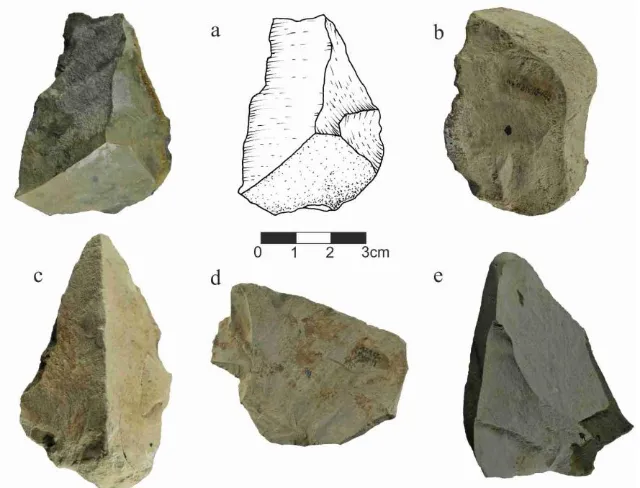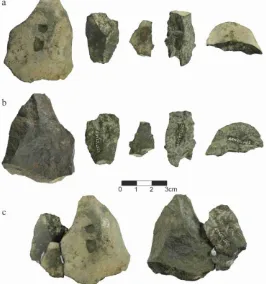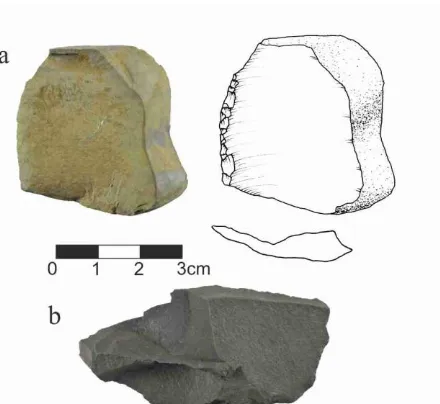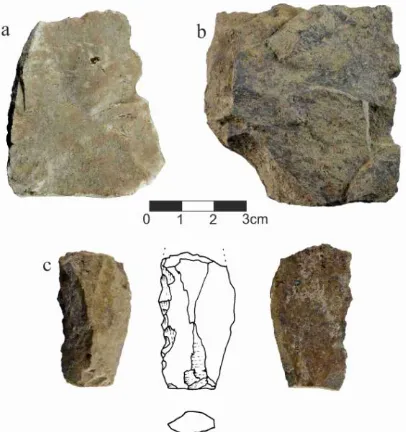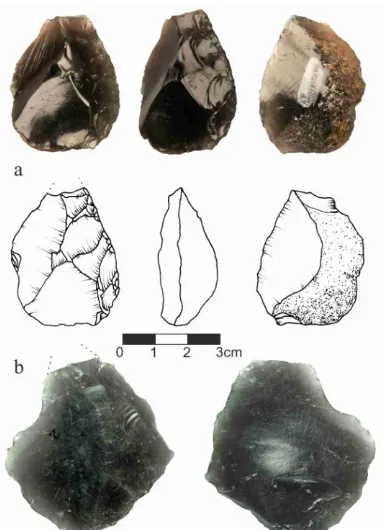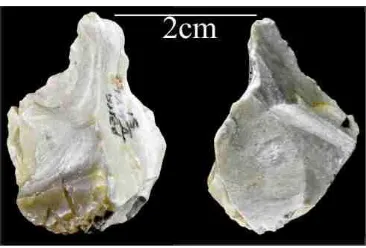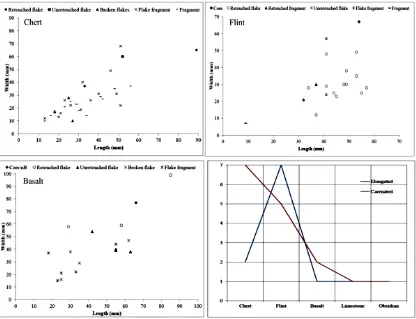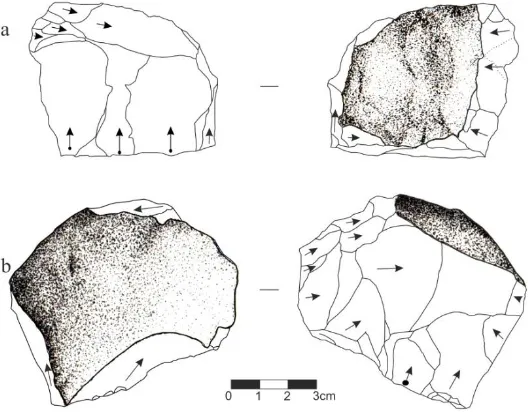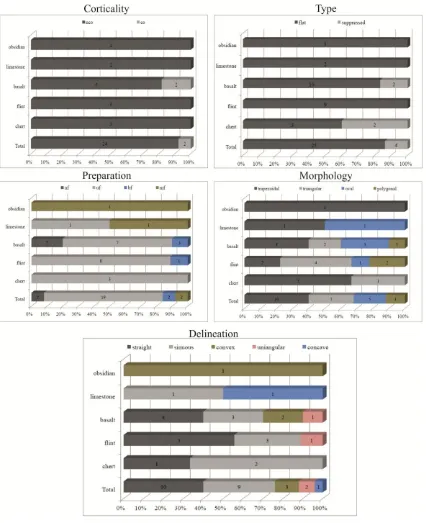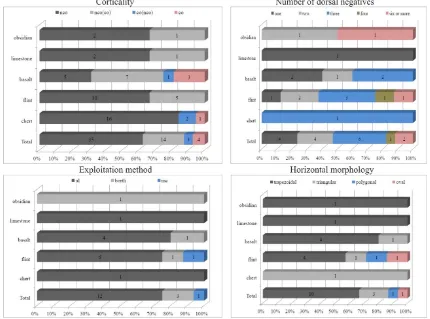LENA ASRYAN
AZOKH CAVE LITHIC ASSEMBLAGES AND THEIR CONTEXTUALIZATION IN THE MIDDLE AND UPPER PLEISTOCENE OF SOUTHWEST ASIA
DOCTORAL THESIS
Supervised by Dr. Andreu Ollé and Dr. Norah Moloney
Department of History and History of Art
Tarragona
We acknowledge that this study titled “Azokh Cave lithic assemblages and their
contextualization in the Middle and Upper Pleistocene of Southwest Asia” presented by
Lena Asryan to achieve a doctoral degree, has been supervised by us in the Institut
Català de Paleoecologia Humana i Evolució Social (IPHES) and Department of History
and History of Art of the University of Rovira i Virgili (URV) and University College
of London (UCL) and that it fulfils the requirements for the International distinction.
Tarragona, 1 of July, 2015
Supervisors of the thesis
xi
Acknowledgments
It has been a long and hard road from the beginning to the end of this thesis and,
although it is often solitary work, many people have supported and helped me in the
fulfilment of this large project.
First of all and most sincerely, I am thankful to both supervisors of this thesis, Dr.
Andreu Ollé and Dr. Norah Moloney. Without their suggestions, comments, advice,
help and great support this would have not been the work it is. The knowledge and skills
I gained from them in the analysis and study of different aspects of stone tools are
immense. Thank you for everything!
I am grateful to the principal and supply members of the committee Dr. Marta
Arzarello, Dr. John Murray, Dr. Marina Mosquera, Dr. Gema Chacón, Dr. Milo Barham
and Dr. Isabel Cáceres and also to two external, independent international researchers
Dr. Dan Adler and Dr. Antony Borel for their suggestions, comments, evaluations and
support not only during their membership of the committee but also during whole
process of study.
To the University Rovira i Vrgili (URV) and Institut Català de Paleoecologia Humana i
Evolució Social (IPHES) (Spain) I am grateful for accepting me and being my Host
Institution during my years of study here. It was a great experience. I am thankful to
Univerità degli Studi di Ferrara (Italy) for being my host institution during the mobility
phase of my pre-doctoral study, and Artsakh State University (Nagorno Karabagh) for
being my Home University and facilitating the process of my research.
To the Department of Tourism and protection of Historical Monuments and to the
Artsakh State Country Museum of the Republic of Nagorno Karabagh, I am grateful for
facilitating access to the Azokh archaeological materials and permits to transport them
abroad for detailed studies.
Special thanks to the Azokh Caves Project. Without the renewed excavations of recent
years and the dedication of all members of the project, it would have been impossible to
undertake this study. A very special thank you to Dr. Tania King and Dr. Yolanda
Fernández-Jalvo for accepting me in the excavations and in the project, and giving me
xii
project members and participants of excavations during these years of my academic and
practical development in archaeology has been of a great value.
For their continuous support, advice and contribution to special aspects of this thesis, I
am grateful to all members of IPHES, but in particular to Eudald Carbonell, Robert
Sala, Ethel Allué, Isabel Cáceres, Josep Vallverdú, Bruno Gómez, María Dolores
García-Antón, Lucía López-Polín, Marina Mosquera, Manuel Vaquero, Xosé Pedro
Rodríguez, Deborah Barsky, Carlos Lorenzo, Josep Maria Vergès, Palmira Saladié,
Rosa Huguet, and Gerard Campeny.
Thanks to the Servei de Microscopia of the URV, in particular to Mercè Moncusí,
Mariana Stefanova, Rita Marimon, Lukas Vojkuvka and Núria Argany for their help
and quick solutions to any unexpected situation occurring during the long hours of
microscopic studies.
To the staff of the parks and natural reserve areas of Riofrío (Segovia), Cabárceno
(Cantabria) and Boumort (Lleida), I am grateful for facilitating the experimental work
undertaken there, and to Yolanda Fernández-Jalvo, Isabel Cáceres, Montse Esteban,
Andreu Ollé and Edgard Camarós, I am thankful for offering the opportunity and
helping me organise all my experimental work in these parks.
I am grateful to Boris Gasparyan for our interesting discussions on Armenian
Pleistocene sites, to Eudald Carbonell, Robert Sala, Gemma Chacon, Marta Arzarello,
Florent Rivals and David Pleurdeau for their important reports on the lithic assemblages
of previous excavations of Azokh.
I am enormously thankful to John Murray, Milo Barham and Edward Lynch for helping
me with the organisation and processing of raw material surveys, analysis and
explanations. I am grateful to Ellery Frahm for helping me understand long lists of
elements and their role in the composition of obsidian.
Thank you to Susana Alonso and Jaume Vilalta for the drawings of lithic artefacts; I am
grateful also to Flick Baker for the illustration of the thesis cover.
I am greatly indebted to the Wenner-Gren Foundation for their financial support and the
xiii
A huge and special gratitude for their continuous personal and professional support
during these years to Amelia Bargalló, Juan-Ignacio Morales, María Soto, Sandra
Bañuls, Virginia Fáundez, Elena Moreno, Paola García, Alex Solé, Arturo de Lombera,
Ivan Lozano, Hugues-Alexandre Blain, Antonio Rodríguez, Joana Gabucio, Patricia
Martín, Antonella Pedergnana, Sabine Martin, Francesca Romagnoli, Tsegai Medin,
Souhila Roubach and Boris Santander. Thanks also to all colleagues with whom I
shared experiences of pre-doctoral studies, Behrouz Bazgir, Karina Morel, Esther López
and many others.
I am grateful to all my friends in Spain, Armenia and elsewhere for supporting me and
making me feel at home everywhere.
Finally, my enormous gratitude to my beloved family in Nagorno Karabagh and to the
Sanz-Pijuan family in Spain for their unconditional love, support and patience. It would
have been really difficult without them.
i
Summary
This study focuses on the Azokh Cave site located in Nagorno Karabagh in the
south-eastern part of the Southern Caucasus. The geographic region forms a corridor linking
Africa, Europe and Asia, and was important for early hominin and other animal
expansion. In this study I discuss patterns of cave occupation, human mobility and
land-use based on analyses and characterisation of the lithic assemblages of the site. The
main chamber - Azokh 1- has provided evidence of repeated occupation by human
groups during the Middle and Late Pleistocene, and at present is the only well stratified
and dated sequence of this time period in the Nagorno Karabagh region. The study is
based on detailed and systematic analyses of raw material, techno-typology, function,
and post-depositional alteration of the assemblages recovered from the upper
sedimentary sequence of the cave (Units V - I) during the 2002 – 2012 excavation
seasons.
The thesis followed four main research questions: 1) What were the mobility and
land-use patterns of Azokh Cave inhabitants? 2) What is the techno-typological place of
Azokh Cave in the region? 3) What type of post-depositional alterations can affect lithic
artefacts in Azokh cave site? 4) What is the nature of the Azokh cave occupation?
To address these research questions several objectives were marked: 1) to study raw
materials used in Azokh Cave; 2) to understand raw material management strategies; 3)
to study and characterise techno-typologically the lithic assemblages from the upper
sedimentary sequence; 4) to place the Azokh lithic assemblages in the context of
Caucasus and other nearby areas; 5) to assess the possibility of undertaking functional
studies of Azokh lithics; 6) to study the post-depositional alterations existing in Azokh,
to understand their origin and development in different units of the cave; 7) to
understand the extent to which all information recovered during recent excavations
allows us to address behavioural and occupational patterns of the cave.
To obtain these objectives and answer the research questions, a methodology was
created based on studies of other researchers combined with new criteria and adapted to
each particular subject of this study.
The studies showed that: 1) In all units the lithic assemblages are made mainly on
ii
sources are present too (particularly in Units V and II). Obsidian is the only rock type
originating from distant sources (> 80 km) and is little represented in most excavated
units. The operative chain is fragmented for all local and non-local rock types and in all
studied units. 2) The lithic assemblage of Unit V is composed primarily of knapping
products which result mainly from unipolar longitudinal and rarely bipolar orthogonal
and multipolar centripetal exploitation. A few flakes and cores show Levallois
tendencies. Sides-scrapers dominate among retouched flakes and some have Quina
attributes. The techno-typological characteristics and chronology of this unit shows
similarities with the Acheulo-Yabrudian techno-culture of the Levant and
Kudaro-Acheulean of the Caucasus. In a wider sense, Unit V is neither typical Mode 2
Acheulean nor Mousterian. Chronologically it is Late Acheulean or pre-Mousterian.
Techno-typologically, at present it can be described as Late Acheulean without
large-cutting tools. 3) The operative chain of the Unit II lithic assemblage consists primarily
of knapping products and more rarely natural bases, cores, knapping waste and debris.
Levallois exploitation dominates in cores and knapping products. Among retouched
artefacts, side-scrapers dominate and there is a good representation of denticulates and
notches. Some points and end-scrapers are also present, as is some small knapping
waste and debris. With these characteristics the Unit II assemblage shares similarities
with the Tabun C-type Mousterian of the Levant, Kudaro-Djruchulian in the Caucasus,
more slightly with Zagros and Karain Mousterian in Iran and Anatolia. The Unit II
assemblage is Mode 3 Mousterian of Levallois facie. 4) The functional study of Azokh
lithics shows that some artefacts from different units bear evident use-wear traces. 5)
The studyof post-depositional alterations showed PDSM affected lithic artefacts of all
units (especially Units V and II) but more particularly the Unit II pieces. Mechanical
alterations were dominant although chemical alterations were common too. Results
from analyses of archaeological pieces together with those from various experiments
suggest that cave bearswere the most important agents of mechanical alterations and
that bats were responsible for most chemical alterations. Thermal alteration is not a
common PDSM in the assemblages; however some samples in all units, but more so in
Unit II, have been affected by thermal alteration related probably to the introduction and
use of firewood at the rear of the cave.
Results of the study of the Azokh lithic assemblages suggest: 1) The occupation of both
iii
longer in Unit II. As both assemblages represent only a marginal area at the back of the
cave, it is difficult to discuss the spatial organisation of occupation in any unit; 2) in
both units the presence of large carnivores (particularly cave bears) was an important
factor affecting the period and duration of cave occupation by hominins; 3) the
characteristics of lithic assemblages in both units indicate they probably included
mobile toolkits, with some isolated evidences of in-situ knapping or retouching
activities; 4) based on current results and taking into consideration the information
provided from previous excavations, it is possible to say that Azokh Cave was not a
residential site, but probably a type of referential site for early hominin groups, who
periodically visited the cave for short occupations to obtain products necessary for
I TABLE OF CONTENTS
Acknowledgments... xi
Summary... i
Table of Contents... I Part 1. INTRODUCTION Chapter 1. Introduction... 3
1.1.Presentation of the topic... 3
1.2.Thesis structure... 4
Chapter 2. State of research... 6
2.1. Introduction... 6
2.2. Dispersal of techno-cultures... 8
2.2.1. Dispersal of Mode 2 Acheulean in Southwest Asia and its local developments... 9
2.2.2 Mode 2 Acheulean to Mode 3 Mousterian transition in Southwest Asia... 15
2.2.3. Mode 3 Mousterian in the Southwest Asia and its local developments... 18
Chapter 3. Research questions... 27
Part 2. THE AZOKH SITE Chapter 4. History of excavations at Azokh Cave... 33
4.1. Excavations during the Soviet period (1960 - 1988)... 33
4.2. Stratigraphy of the Azokh 1 Cave entrance from the previous excavations... 34
4.3. Archaeological remains from previous excavations... 35
4.4. History of renewed research at Azokh Cave... 39
Chapter 5. Geomorphology and geology of Azokh Cave... 46
5.1. Site formation and stratigraphy... 46
5.2. Azokh 1... 48
5.3. Azokh 2... 54
5.4. Azokh 5... 54
5.5. Summary geology and geomorphology of Azokh Cave... 55
Chapter 6. Summary of results of recent excavations... 57
6.1. Human remains... 57
6.1.1. Homo heidelbergensis remains... 57
6.1.2. Neanderthal remains... 58
6.1.3. Modern human remains... 58
6.2. Faunal remains... 59
6.2.1. Large mammal remains... 59
6.2.2. Small vertebrate remains... 61
6.3. Charcoal remains... 62
6.4. Other remains... 63
6.5. Summary... 63
Part 3. STUDIES UNDERTAKEN Chapter 7. Raw materials study... 67
7.1. Methodology of raw material study 67 7.1.1. Methodology for RMS: Material and methods for the geological survey in the vicinity of Azokh Cave... 67
7.1.2. Methodology for RMS: Materials and methods for macro- and microscopic studies of sampled raw materials... 69
7.1.3. Methodology for RMS: Materials and methods for studying the raw materials of Azokh Cave lithic assemblages... 73
II
7.2.1. Literature review of the geological formation of the Caucasus... 91
7.2.2. Results of the raw material survey in the area immediately surrounding Azokh Cave... 96
7.2.3. Results of microscopic analysis of sampled volcanic rocks... 106
7.3. Results of raw material studies of Azokh Cave lithic assemblages... 116
7.3.1. Results of raw material studies... 116
7.3.1.1. Chert... 119
7.3.1.2. Flint... 125
7.3.1.3. Basalt... 135
7.3.1.4. Limestone... 148
7.3.1.5. Obsidian... 154
7.3.1.6. Jasper... 162
7.3.1.7. Sandstone... 165
7.3.1.8. Chalcedony, agate and silopal... 169
7.3.1.9. Andesite and gabbro... 172
7.4. Raw material study: Summary... 176
Chapter 8. Techno-typological studies... 179
8.1. Methodology for the morpho-technical and typological studies of lithic artefacts... 179
8.1.1. Methodological approach... 179
8.1.2. Morpho-technical and typological analyses: General characteristics... 180
8.1.3. Methodology for refitting... 196
8.2. Techno-typological analysis results... 199
8.3. Results of the techno-typological analysis of Unit V lithic artefacts... 202
8.3.1. Operative chain of chert artefacts... 203
8.3.2. Operative chain of flint artefacts... 209
8.3.3. Operative chain of basalt artefacts... 223
8.3.4. Operative chain of limestone artefacts... 233
8.3.5. Operative chain of obsidian artefacts... 234
8.3.6. Operative chain of artefacts made of other raw materials... 236
8.3.7. Summary and discussion of Unit V techno-typological analysis results... 237
8.3.8. Conclusions: Unit V operative chain... 244
8.4. Results of the techno-typological analysis of Unit IV lithic artefacts... 249
8.5. Results of the techno-typological analysis of Unit III lithic artefacts... 251
8.5.1. Operative chain of chert artefacts... 252
8.5.2. Operative chain of flint artefacts... 255
8.5.3. Operative chain of basalt artefacts... 256
8.5.4. Operative chain of artefacts of other rocks... 257
8.5.5. Summary and discussion of Unit III techno-typological analysis results... 259
8.5.6. Conclusions: Unit III operative chain... 260
8.6. Results of the techno-typological analysis of Unit II lithic assemblage 261 8.6.1. Operative chain of chert artefacts... 263
8.6.2. Operative chain of flint artefacts... 270
8.6.3. Operative chain of basalt artefacts... 293
8.6.4. Operative chain of limestone artefacts... 311
8.6.5. Operative chain of obsidian artefacts... 315
8.6.6. Operative chain of artefacts made of other raw materials... 319
8.6.7. Summary and discussion of Unit II techno-typological analysis results... 325
8.6.8. Conclusions: Unit II operative chain... 336
8.7. Results of the techno-typological analysis of Unit I lithic assemblage... 340
8.7.1. Operative chain of chert artefacts... 341
8.7.2. Operative chain of flint artefacts... 341
8.7.3. Operative chain of artefacts of other raw materials... 343
8.7.4. Summary and conclusions of Unit I techno-typological analysis results... 344
Chapter 9. Functional studies... 346
III
9.1.1. Methodological approach... 346
9.1.2. Methodology of functional analysis of archaeological lithic artefacts... 347
9.1.2.1. Cleaning and preparation of lithics for microscopic observation... 348
9.1.2.2. Microscopic observation methodology... 349
9.1.3. Methodology of functional experiments... 351
9.1.3.1. Preparation of experimental flakes... 351
9.1.3.2. The experiments... 353
9.1.3.3. Post-experimental cleaning of samples and microscopic study... 355
9.2. Functional studies of experimental flakes: results... 356
9.2.1. Macroscopic analysis of experimental flakes... 356
9.2.2. Microscopic analysis of experimental flakes... 356
9.2.3. Functional analysis of experimental flakes: summary and discussion... 359
9.3. Functional analysis of archaeological artefacts: results... 363
9.3.1. Raw materials involved... 367
9.3.2. Technological categories involved... 368
9.3.3. Size categories involved... 370
9.3.4. Characteristics of use-wear traces... 371
9.3.5. Actions and material worked... 373
9.3.6. Traces not related to the use... 381
9.3.7. Samples with evidence of mixed traces... 384
9.3.8. Samples without wear traces... 384
9.3.9. Summary and discussion of functional analysis results of archaeological stone tools... 385
Chapter 10. Post-depositional surface modification (PDSM) studies... 399
10.1. Methodology for the PDSM studies... 399
10.1.1. Methodology of PDSM analysis of archaeological pieces... 399
10.1.1.1. Mechanical alterations... 399
10.1.1.2. Chemical alterations... 406
10.1.1.3. Thermal alterations... 407
10.1.2. Methodology of PDSM experiments... 409
10.1.2.1. Deer trampling experiment... 411
10.1.2.2. Human trampling experiment... 415
10.1.2.3. Bear trampling and tumbling experiments... 419
10.1.2.4. Bat guano experiment... 427
10.2. PDSM studies results... 431
10.2.1. PDSM analysis of archaeological lithic artefacts... 431
10.2.1.1. Mechanical alteration results... 432
10.2.1.2. Summary of mechanical alterations of archaeological artefacts... 443
10.2.2. Results of experiments related to the mechanical alteration of artefacts... 446
10.2.2.1. Deer trampling experiment (DTE) results... 446
10.2.2.2. Human trampling experiment (HTE) results... 449
10.2.2.3. Results of bear trampling (BTE) and tumbling (TE) experiments... 453
10.2.2.4. Summary and discussion of experiments related to mechanical alteration... 462
10.2.3. Comparison of results of post-depositional (mechanical) alteration of archaeological and experimental pieces... 466
10.3. Chemical alteration study results... 478
10.3.1. Chemical weathering of archaeological artefacts... 478
10.3.2. Results of experiments related to chemical alteration of artefacts... 483
10.3.3. Summary and comparison of the results of chemical alteration analysis of archaeological and experimental artefacts... 488
10.4. Thermal alteration... 489
10.4.1. Thermal alteration of archaeological artefacts... 489
10.4.2. Summary of the results of thermal alteration of archaeological artefacts... 491
IV
Part 4. DISCUSSION and CONCLUSIONS
Chapter 11. Discussion and interpretation of results... 497
11.1. Raw material economy... 497
11.2. Technological and typological characteristics of Azokh Cave lithic assemblages in micro- and macro-regional context... 506
11.2.1. Unit V... 506
11.2.1.1. Summary of results... 506
11.2.1.2. Comparison between the assemblages recovered during the current and previous excavations... 508
11.2.1.3. Unit V lithic assemblage in the Southwest Asian context... 510
11.2.2. Units IV and III... 515
11.2.3. Unit II... 517
11.2.3.1. Summary of results... 517
11.2.3.2. Comparison between the assemblages recovered during the current and previous excavations... 519
11.2.3.3. Unit II lithic assemblage in the Southwest Asian context... 523
11.3. Functional analysis: activities identified... 534
11.4. Post-depositional alterations... 538
11.4.1. Mechanical alterations... 538
11.4.2. Chemical alterations... 543
11.4.3. Thermal alterations... 545
11.5. Azokh Cave occupation... 548
Chapter 12. Conclusions... 557
Chapter 13. Future perspectives... 566
Bibliography... 571
ANNEX to Chapter 10... 611
List of Tables... 651
Part 1:
INTRODUCTION
Chapters 1 - 3
Introduction
State of research
Azokh Cave lithic assemblages and their contextualization in the Middle and Upper Pleistocene of Southwest Asia
3
Chapter 1. Introduction
1.1. Presentation of the topic
The Caucasus is a mountainous region that stretches between the Black Sea in the West
and the Caspian Sea in the East. The Greater Caucasus, the main and the largest
mountain range, includes the south-western part of Russia and northern parts of Georgia
and Azerbaijan. The Lesser Caucasus runs parallel to the Greater Caucasus and delimits
the Armenian Highland. Located as it is in the middle of the African, Asian and
European continents, the Caucasus region represents a geographic corridor for the
expansion and migration of human and animal populations, although the high
mountains and difficult passes of the region might have limited human mobility and
expansion in this territory.
Hominin presence in the Caucasus is attested by rich palaeoanthropological and cultural
remains found throughout the Early to Upper Pleistocene. As yet, it is difficult to obtain
complete information for some important sites in the Caucasus given the poor quality of
excavations carried out in the past, or because of restricted publications (characteristic
of Soviet period investigations) and difficulties of access and study of the material
recovered in past excavations (e.g. Treugol’naya, Kudaro, Tsona, Weasel, Il’skaya etc.).
However, in the last few years many other sites have been subjected to renewed,
multidisciplinary excavations and studies (e.g. Ortvale Klde, Sakadjia, Ortvala, Bronze
Cave, Lusakert etc.) allowing us to better understand hominin and other animals passing
through the Caucasus and their evolution in this region. Moreover, a number of new
sites have been discovered and studied (most of them currently under study) during
recent surveys and excavations in many different areas of the Caucasus region
(particularly in Georgia and Armenia) involving new researchers, different institutions,
and involving more systematic investigation, the results of which are regularly
disseminated through publications and reports, etc. Nonetheless, there are still many
areas and sites in this region that have yet to be fully surveyed, excavated and studied,
particularly in the area where Azokh Cave, the site of interest of the current study, is
located.
The focus of this study is the Azokh Cave site located in the south-eastern part of the
Southern Caucasus, in Nagorno Karabagh (39º 37.15N and 46º 59.32E). In particular,
1.Introduction
4
characterisation of the lithic assemblages of the site will be discussed. The cave is about
850 m a.s.l., 200 m above the nearby village of Azokh. The main chamber-Azokh 1- has
provided evidence of repeated occupation by human groups during the Middle and Late
Pleistocene, which, at present, is the only well stratified and dated sequence of this time
period in the Nagorno Karabagh region. The study is based on detailed and systematic
analyses of raw material, techno-typology, function, and post-depositional alteration of
the assemblages recovered during the 2002 – 2012 excavation seasons from the upper
sedimentary sequence of the cave (Units V - I). Moreover, the results obtained from the
study of lithic assemblages were compared to those of other disciplines and lithic
assemblages of similar chronologies in the neighbouring regions (e.g. Levant, Anatolia,
Iranian Plateau and other areas of the Caucasus).
1.2. Thesis structure
As many different aspects (e.g. raw materials, techno-typology, functional and
post-depositional alterations) of lithic artefacts were studied in this thesis and many different
methodologies and techniques were applied, the methodology of study is not presented
as a separate chapter but is presented together with the results of each particular subject
(e.g. the methodology of typological studies together with the chapter of
techno-typology and so on) to make it easier to follow the whole process of study and
terminologies and methods used. At the end of each chapter short summaries and
discussions are presented, highlighting the most important aspects of each particular
subject, which are further developed in the final discussion.
The thesis is structured around four main parts. Part 1 comprises the first three chapters;
Chapter 1 presents the topic and provides an introduction to the other chapters; Chapter
2 provides a brief overview and the state of research of the most important aspects of
the dispersion of Acheulean and Mousterian techno-complexes in the Levant, Anatolia,
Iran and the Caucasus. It sets the background context for comparisons with the Azokh
Cave assemblages which will be presented in the discussion section in Part 4 (see
below). Chapter 3 presents the main goals and objectives of this study.
Part 2 presents the Azokh Cave site. In Chapter 4, summaries of the available
information on the excavations, stratigraphy and finds of previous (Soviet period)
excavations and the history of renewed excavations are presented. Chapters 5 and 6
Azokh Cave lithic assemblages and their contextualization in the Middle and Upper Pleistocene of Southwest Asia
5
non-lithic remains found during recent excavations in the upper sedimentary sequence
of the cave.
Part 3 comprises the chapters on the methodology and results of each of the main
studies undertaken with lithic assemblages. Chapter 7 includes the methodology for the
survey and study of raw materials of Azokh, a review of geological formations in the
Caucasus (Armenia and Nagorno Karabagh in particular), results of surveys in the areas
close to the cave, and results of the raw materials studies of Azokh archaeological
assemblages and their comparison with survey results. Chapter 8 presents the
methodology and results of techno-typological studies of lithic assemblages of different
units of Azokh. Chapter 9 includes the methodology and results of use-wear related
experiments, the functional study, and comparison of experimental and archaeological
assemblages. Chapter 10 presents the methodology and results of experiments related to
post-depositional alteration (mechanical and chemical), and comparison with the Azokh
archaeological assemblages.
Finally, Part 4 includes chapters on discussion, conclusions and future perspectives.
Chapters 11 and 12 provide a summary of results, discussion, interpretation and
conclusions of hominin mobility and site occupation patterns as well as placing the
Azokh Cave lithic assemblages in the context of the Caucasus and other areas of
Southwest Asia. Finally, there is a section about future perspectives and continuity of
this study. Data tables that are of interest, but not critical to the narrative of the main
2.State of research
6
Chapter 2. State of research
2.1. Introduction
Four different routes have been suggested for the dispersal out of Africa of humans
(H.ergaster/H.erectusor early H.sapiens) and other animals. Three of these routes
involve water crossing (the Sicilian Channel, the Straits of Gibraltar, and Bab
el-Mandeb in the Southern part of the Red Sea) and one (the Sinai peninsula) is a land
route (van Peer 1998, Stringer 2000, Bar-Yosef & Belfer-Cohen 2001, Rightmire 2001,
Roebroeks 2001, Dennell 2003, Dennell & Roebroeks 2005, Derricourt 2005, Beyin
2006, Bar-Yosef & Belmaker 2011, Bar-Yosef & Belfer-Cohen 2013, Boivin et al.
2013). There are many theories and hypotheses concerning possibilities of early
hominins using the Sicilian Channel and the Strait of Gibraltar to reach the European
continent (Alimen 1975, Arribas & Palmqvist 1999, Turner 1999, Straus 2001, Villa
2001, Sahnouni et al. 2002, Geraads et al. 2002), some of which are contradictory or
poorly developed. However, here questions related to these two possible passageways
will not be discussed. Instead, attention will focus on the two other routes
(Bab-el-Mandeb and Sinai Peninsula), which are most closely related to hominin dispersal
through Southwest Asia in general, and the Caucasus in particular, and therefore may
help understand aspects related not only to hominin dispersal in this territory but also
the cultural, behavioural and other characteristics they brought with them.
Bab-el-Mandeb connects Red Sea with the Gulf of Aden and is a direct route from
sub-Saharan Africa to the Arabian Peninsula (south-western part of the peninsula in
particular). Methods of crossing the strait (i.e. use of water or land bridges appearing
during the periodic lowering of the water level in the Red Sea) and the capability (i.e.
physical, mental, behavioural preparation) of early hominins to use a particular route for
their migration from Africa to Southwest Asia is a question of debate (Bar-Yosef &
Belfer-Cohen 2001, Petraglia 2003, Derricourt 2005, Bar-Yosef & Belmaker 2011).
However, both land and sea bridges were considered to be potential dispersal routes for
this region. During the Pliocene and Pleistocene, the only real land route out of Africa
was through Sinai. Ecologically, this peninsula is an extension of the eastern desert of
Egypt and is a link to the Negev desert. As yet there is no good archaeological evidence
on which to reconstruct the trajectory of early hominin movement from Africa to Asia
Azokh Cave lithic assemblages and their contextualization in the Middle and Upper Pleistocene of Southwest Asia
7
movement out of Africa was strongly bounded by time and space and that the choice of
a particular zone for a land-crossing was dependent on climatic conditions.
Based on data obtained from Lower Palaeolithic sites in various parts of Eurasia, the
general consensus is that the first migration from Africa occurred around 1.8 – 1.5 Ma
and that the first Homo species to take the migration route was Homo erectus/ergaster
(Bar-Yosef 1994, Swisher et al. 1994, Gabunia & Vekua 1995, Potts 1998, Arribas and
Palmqvist 1999, Tchernov 1999, Bar-Yosef & Belfer-Cohen 2001, Belmaker et al. 2002
among others). The archaeological evidence from the Lower and early Middle
Pleistocene in the large Eurasian continent is still rather limited, and secure dates for the
rare human fossils, isolated artefacts, or even rich, well-excavated lithic assemblages are
few. As human fossil remains are scarce in the archaeological sites and lithic artefacts
are the most common archaeological finds, the mere presence of the latter is usually
used to explain hominin dispersal out of Africa. Southwest Asia is no exception to these
general criteria and lithic artefacts, sometimes combined with palaeoanthropological
and palaeontological studies, are taken into consideration to address questions related to
hominin and other animal migration routes as well as their cultural and behavioural
adaptation to different environments, subsistence strategies etc. Based on excavations
carried out at different archaeological sites in Southwest Asia and taking into account
the patchy chronological information and the physiogeographic variation of this region
from north to south and west to east, four different sub-regions have been distinguished
here:
Anatolia,
The Southern Caucasus,
The Zagros mountains and the Iranian plateau,
The Levant and the Arabian Peninsula.
In this thesis, apart from all these sub-regions (above), the sites in the Northern
Caucasus are discussed too and these are included under the general heading of
Southwest Asia.
Among these sub-regions, the Levant is better known because of its archaeological
sites, excavations, and state of research. In the other larger regions such as the Iranian
and the Anatolian plateau there is an imbalance between the areas in information or
2.State of research
8
Derricourt 2006, Bar-Yosef & Belmaker 2011). During the Miocene there was a land
bridge between Africa and the Levant, allowing the migration of various plants and
animals through this territory (Tchernov 1988, Bar-Yosef 1994, 1998a). Moreover the
region was accessible via southern (Bab-el-Mandeb straight) and northern (Nile river
and Sinai Peninsula) paths, which during the Early and Middle Pleistocene served as
potential dispersal routes for hominin migrations. This is attested by several as yet
undated sites in the Levant (e.g. Yiron with evidence of a core and flake industry
(Ronen 1991a), the Erq el Ahmar Formation in the Jordan Valley, which is considered
to be „prior to the Ubeidiya‟ formation identified with the Olduvai subchron (Ron &
Levi 2001, Bar-Yosef & Belmaker 2011) and in the Caucasus (e.g. Kvabedi with a
number of assemblages derived from various accumulations (Vekua & Lordkipanidze
2008, Agustí et al. 2009). Based on correlation of the faunal assemblage and the
stratigraphic sequence with other sites within the region and also the sites of similar
chronology in Europe, an age older than 1.8 Ma is suggested for these sites. Several
well excavated and contextualised sites with evidence of early hominin anthropological
and cultural remains in this region are known too which cover an age span between 1.8
– 0.8 Ma. Of great importance are the sites of „Ubeidiya, Evron-Quary, Latamne, Bizat Ruhama, and Gesher Benot Ya‟aqov in the Levant (Ronen 1991b, Bar-Yosef &
Goren-Inbar 1993, Sanlaville et al. 1993, Ronen et al. 1998, Bar Yosef & Belfer-Cohen 2001,
Ron and Gvirtzman 2001, Ron et al. 2003, Zaidner et al. 2003, 2010), Dmanisi in the
Caucasus (Gabunia & Vekua 1995, Rightmire et al. 2006, Lordkipanidze et al. 2007),
and Dursunlu and Keltepe Deresi (layers V – XII) in Central Anatolia (Güleç et al.
1999, 2009, Slimak et al. 2004, 2008, Kuhn 2010). Hominin presence and their
dispersal through Southwest Asian regions is confirmed also by a number of other
Middle and Upper Pleistocene sites (see below).
2.2. Dispersal of techno-cultures
During their „Out of Africa‟ sortie, early hominins were not only the transporters of
their own anthropological species but also the bearers and deliverers of their cultural
and behavioural traditions. It is known that the earliest out of Africa expansion involved
hominin groups representing the so- called core-chopper industries (around 1.7 – 1.6
Myr) (Bar-Yosef & Belfer-Cohen 2001, Dennell 2004, Derricourt 2006, Bar-Yosef &
Azokh Cave lithic assemblages and their contextualization in the Middle and Upper Pleistocene of Southwest Asia
9
In Southwest Asia some well stratified and dated sites were found with evidence of
early core-flake or core-chopper, Mode 1 Oldowan industry associated mainly with the
Homo erectus/ergaster out of Africa dispersal in this region (e.g. Dmanisi (Georgia, 1.8 – 1.6 Myr), „Ubeidiya (Israel, 1.5 – 1.0 Myr) and Dursunlu (Anatolia, 1.0 – 0.8 Myr)
(Bar-Yosef & Goren-Inbar 1993, Liubin & Boisinski 1995, Lordkipanidze et al. 2007,
Carbonell et al. 2008, 2010, Güleç et al. 2009, Bar-Yosef & Belmaker 2011), although
the lithic assemblages of some of the „Ubeidiya layers have been defined as “Developed Oldowan B” or Early Acheulean (Bar-Yosef & Goren-Inbar 1993). In-depth discussion
here on the dispersal and development of different techno-typological groups is not the
subject of this study; however, a summary of the expansion and local development of
some techno-typological groups, particularly Mode 2 Acheulean and Mode 3
Mousterian is provided below.
2.2.1. Dispersal of Mode 2 Acheulean in Southwest Asia and its local developments
The principal characteristics for full Mode 2 Acheulean assemblages have been defined
as follows (Clark 1994, Wynn 1995, Wenban-Smith 1998, 2004):
The use of well-made symmetrical handaxes together with cleavers or the
development of so-called large cutting tool (LCT) industry
Diversification of knapping methods (widespread use of the unipolar knapping
method in earlier assemblages, and increase in bipolar and centripetal
techniques)
The use of small, highly diversified and finely shaped retouched tools
The widely held hypothesis in Palaeolithic archaeology is that the Acheulean or
so-called Mode 2 originated in East Africa approximately 1.7 – 1.6 Myr ago; however,
shifts in basic knapping methods and the development of the final morphology of
bifaces indicate a later dispersal (ca. 1.4 – 1.0 Myr) of this new technology and its
bearers outside of Africa and across many regions of Palaeolithic Old World (Clark
1994, Carbonell et al. 1999a, Goren-Inbar et al. 2000, Aguirre & Carbonell 2001,
Bar-Yosef & Belfer-Cohen 2001, Lycett et al. 2008, Carbonell et al. 2010, Mosquera et al.
2013). The distribution of the Acheulean, its variability and development stages in
different regions, and its presence or absence east of the Movius line (i.e. the line which
traditionally has been considered to represent a geographic separation between the
2.State of research
10
eastern Eurasia) have been a question of debate for many decades (Roe 1976, Wynn
1979, Callow 1986, Clark 1994, Carbonell et al. 1999a, Clark 2001, McNabb et al.
2004, Lycett & Cramon-Taubadel 2008). The absence or limited presence of
well-stratified Acheulean sites of > 1.0 Myr outside Africa also caused quite an intensive
debate about the chronology of the Acheulean Mode 2 dispersal throughout Eurasia. At
present, there are no well dated early Acheulean sites in Southwest Asia which suggests
that the hominins who made the core and flake industry were also responsible for the
production of the early Acheulean lithics.
Available data indicates slightly later (< 750 Kyr) appearance of early Mode 2
Acheulean technology not only in Southwest Asia but also in Europe (Bar-Yosef &
Belfer-Cohen 2001, 2013, Dennell 2003, Dennell & Roebroeks 2005, Derricourt 2005,
Bar-Yosef & Belmaker 2011, Dennell 2011, Mosquera et al. 2013), although recent
studies at the sites of Barranc de la Boella (Spain) (Vallverdú et al. 2014, Mosquera et
al. in press) and la Noire (France) (Moncel et al. 2013) indicate an earlier appearance of
the Early Acheulean in Europe than previously thought. In Southwest Asia, the early
Acheulean assemblages are evidenced in the sites of Gesher BenotYa‟aqov in Israel
(Goren-Inbar et al. 2004) and Latamne in Syria (Clark 1967, Bar-Yosef 1998a). These
two sites, with their clear preference for using basalt as the main raw material (although
good quality flint and limestone were locally available) for the production of cleavers,
are considered to be the direct bearers of East African early Acheulean traditions
(Bar-Yosef 1994, 1995). The so-called, Middle and Late Acheulean assemblages,
nevertheless, became widely dispersed in Southwest Asia (as well as in Europe) around
500 – 250 Kyr and in all sites with human remains this industry was usually associated
with Homo heidelbergensis (Yosef & Belfer-Cohen 2001, Dennell 2003, 2011,
Bar-Yosef & Belmaker 2011, Mosquera et al. 2013). This period in the Levant is tightly
linked to the Acheulo-Yabrudian techno-culture widely dispersed from the foothills of
Taurus to the central Levant (Jelinek 1982 a,b, Copeland & Hours 1983, Bar-Yosef
1994, 1998a, Bar-Yosef & Belfer-Cohen 2001, Dibble & McPherron 2006, Bar-Yosef
& Belmaker 2011, Kuhn & Clark 2015). It is considered to be stratigraphically below
Early Mousterian layers covering a time span between ~450 – 220 Kyr. Based on
techno-typological differences three phases were defined within the Acheulo-Yabrudian
techno-culture:
Azokh Cave lithic assemblages and their contextualization in the Middle and Upper Pleistocene of Southwest Asia
11
2. Yabrudian - abundance of flake production and presence of heavy scrapers often
made on thick blanks with scalar Quina retouch. Although, a few Levallois-type
products are present, there is no well-identified Levallois method in this group.
3. Amudian (or Pre-Aurignacian) - abundant blade production and good presence
of end-scrapers, burins, backed knives and some other Upper Plaeolithic
tool-types; rare bifaces.
The sites of Tabun, Qesem, Yabrud I, Misliya, Jamal, Hummal among others in the
Levant (Bar-Yosef & Belfer-Cohen 2001, Porat et al. 2002, Zaidner et al. 2005, 2006,
2012, Bar-Yosef Belmaker 2011, Shimelmitz & Kuhn 2013, Shahack-Gross et al. 2014,
Kuhn & Clark 2015) have been described as the most evident representatives of this
culture.
Anatolia and the Iranian plateau, although geographically natural bridges between
different continents and different parts of Asia and, therefore, supposedly one of the
main routes for hominin expansion out of Africa, have provided little evidence for
hominin occupation. Researchers (Kuhn 2002, Biglari & Shidrang 2006, Bar-Yosef &
Belmaker 2001, Biglari & Jahani 2012) relate it mainly to the paucity of research in
these regions and scarcity of surveys which would allow discovery of new sites.
However, recent studies in these regions have revealed several Early to Upper
Pleistocene sites, which contain valuable information about early hominin dispersals. In
Anatolia, apart from the Early Pleistocene site of Dursunlu discussed above, three other
sites have been discovered and studied: Yarimburgaz (western Anatolia), Karain cave
(Mediterranean coast of Anatolia) and Kaletepe Deresi 3 (central Anatolia). The
Acheulean layers of these sites are dated between 400 – 250 Kyr. Based on such
characteristics of the lithic artefacts as dominance of flakes, use of thick blanks for
retouching, dominance of side-scrapers among retouched tools, scarcity of large cutting
tools, rare use of Levallois technology, the lithic assemblages from these sites were
termed as Acheulo-Yabrudian of the Levant or Clactonian/proto Charentian of Europe
(Kuhn et al. 1996, Stiner et al. 1996, 1998, Arsebük & Özbaşaran 1999, Kuhn 2002,
2010).
The situation with sites of the Zagros Mountains and Iranian Plateau is more
complicated as apart from being small in number, most sites here remain undated and
2.State of research
12
with other sites mainly in the Levant or the Caucasus (Biglari & Jahani 2012). The lithic
artefacts of the recently discovered open-air site of Ganj Par and Darband Cave in Iran,
although scarce, have been considered as Acheulean assemblages based on certain
characteristics (e.g. presence of bifacial handaxes, cleavers, picks) (Biglari & Shidrang
2006, Biglari & Jahani ibid). Although some assemblages from Barda Balka (Iraqi
Kurdistan) were considered to be Late Acheulean (Vahdati Nasab et al. 2013, How &
Rowman 2014), no clear dates have been presented for this assemblage or for the layers
from which these artefacts were recovered.
In the Caucasus, the scarcity of sites and poorly developed surveys, have raised debates
about the presence of Early Acheulean assemblages in this region. While some authors
(Lioubin 2002, Liubin & Beliaeva 2004) insisted on the idea of the presence of Early
Acheulean assemblages in some Caucasian sites (e.g. Amirans Gora, Darvagchai I),
others (Golovanova 2000, Doronichev et al., 2004, Doronichev 2008, Doronichev &
Golovanova 2010) questioned the chronology and recovery of these materials from
undisturbed deposits. Until recently, it was believed that the open-air site of Amiranis
Gora in Southern Georgia was a unique Early Acheulean stratified location close to
„Ubeidiya in age (Gabunia et al. 2000). This site provided rich mammalian fauna and a
few lithic artefacts. Recent excavations of the site, however, have shown that the age of
the faunal assemblage was of 1.0 to 0.8 Myr, but this was not associated with in situ
lithic artefacts (Tappen et al. 2002). Some possible lithic artefacts composed of flakes,
cores and some retouched flakes were found in Darvagchai I (Dagestan). These were
approximately dated to the early Middle Pleistocene (800 – 600 Kyr) and were
described as Early Acheulean (Amirkhanov & Derevianko 2004, Derevianko 2006).
However, the heavily abraded character of these artefacts and also absence of clear
(anthropic character) large cutting tools raised some doubts about this assemblage and
its techno-typological features. In the Northern Caucasus only Treugol‟naya Cave
(Russia) seems to have reliably dated Lower to Middle Palaeolithic human settlement.
Its Assemblages IV and III are composed of a small flake tool and pebble macro-tool
based industry, without Acheulean bifaces, covering a time range from 600 to 400 Kyr
(Doronoichev et al. 2004, Doronichev 2008). These assemblages are defined as
pre-Mousterian or Tayacian. Weasel Cave (Mishtulagti Lagat) in Ossetia, is another Middle
to Upper Pleistocene site in the Northern Caucasus. Some Lower Palaeolithic lithic
Azokh Cave lithic assemblages and their contextualization in the Middle and Upper Pleistocene of Southwest Asia
13
fauna, were dated 400 – 250 Kyr (Hijrati et al. 2003). The small lithic assemblage was
composed of some flake tools and a chopper defined as Tayacian. Some lower layers of
Kudaro I cave (stratum 8a) and Azokh cave (layers VII – VIII) were considered to have
early Acheulean assemblages too, but several authors (e.g. Lioubin 2002, Doronichev
2008) questioned not only the nature of these “lithic artefacts” but also the early dates
provided.
Doronichev (2001, 2008) and colleagues (Doronichev et al. 2004, 2007) suggested a
late appearance of the true Acheulean techno-complex in the Caucasus in comparison to
other sites in Southwest Asia, giving an age no older than 350 Kyr for the earliest
Acheulean industries in the Southern Caucasus. Furthermore, they highlighted the
limited distribution of the Acheulean techno-complex in the Lesser Caucasus and
Central Southern Caucasus. Lioubin (2002) suggested that natural boundaries, such as
the mountain ranges of the Caucasus, were the reason for a decreasing number of
Acheulean handaxes and true Early Acheulean sites in the Caucasus, as he believed,
these mountains limited early hominin movement in the region. Based on several
stratified assemblages two specific Acheulean groups were suggested for the Southern
Caucasus (Doronichev 2008):
1. Kudarian (from Acheulean assemblages at the cave sites of Kudaro I, Kudaro
III, and Tsona) is characterised by the use of sedimentary rocks, abundance of
flakes, high frequency of retouched tools (particularly side-scrapers), rare
Acheulean (Kudarian) bifaces and absence of Levallois technology.
2. The Acheulean variant is characterised by the use of volcanic rocks, presence of
numerous Acheulean bifaces, laminar and Levallois debitage (Doronichev 2004,
2008)
Some layers of Kudaro I (layers 4 - 5) and III (layers 4 – 8), Tsona (layers 2 – 5) and
also the assemblages recovered during the Soviet period excavations of Azokh cave
(layers VI and V) were considered to be part of the so-called Kudaro-Acheulean
techno-culture in the Southern Caucasus (Doronichev 2008).
Recent discoveries in Armenia have shown evidence of Early to Late Acheulean lithic
assemblages in the sites of Aghvorik (Shirak Depression), Aghavnatun (Ararat
Depression), Dashtadem 3 (northern Armenia) and Nor Gehi 1 (Hrazdan-Kotayk
2.State of research
14
(e.g. Aghvorik, Aghavnatun) there is lack of reliable contextual information, others
(Dashtadem 3, Nor Geghi 1) have well-contextualised Late Acheulean assemblages.
Moreover, in the case of Nor Geghi1, the Late Acheulean assemblage (e.g. ovate and
triangular bifaces, large and thick flakes) is associated with the early Middle
Palaeolithic artefacts (e.g. Levallois blades, denticulates, truncated-faceting) perhaps
suggesting the presence of Late Acheulean to Mousterian transition at this site (Adler et
al. 2012, 2014, Gasparyan et al. 2014a) (see more details in section 2.3).
In summary, it can be stated that:
During the Lower and Middle Pleistocene both land and sea bridges were likely
used by early hominin dispersal from Africa to Southwest Asia. All sub-regions
of this geographic area (the Levant and Arabian Peninsula, the Zagros
mountains and the Iranian plateau, Anatolia and the Caucasus) were inhabited in
the Lower Pleistocene, as evidenced by some well-stratified sites in the Levant,
Anatolia and the Caucasus. This was testified by palaeoanthropological and
palaeontological remains as well as by the presence of core-chopper Mode
1/Oldowan industries.
Although the available data indicates expansion of new Mode 2 - Acheulean
technology and its bearers out of Africa around 1.4 – 1.0 Myr, the absence of
well-stratified and contextualised sites in Southwest Asia does not indicate this
new technology here until approximately 750 Kyr. Even then, archaeological
sites with early Acheulean assemblages of these chronologies are scarce and are
known only from the Levant (e.g. Gesher Benot Ya‟aqov, Latamne) and perhaps in some Caucasus sites (e.g. Treugol‟naya).
Acheulean assemblages were widely dispersed in the Southwest Asia around
500 – 250 Kyr, evidenced in a number of sites in the Levant, the Caucasus, and
to a lesser degree in Anatolia and the Iranian Plateau.
While the lithic assemblages of this period in the Levant and Anatolia are tightly
related with the Acheulo-Yabrudian techno-culture, sites in the Caucasus are
associated with the Kudaro-Acheulean. In fact these two local technological
groups share many techno-typological similarities (e.g. abundance of flakes and
retouched tools, use of thick blanks for retouching (these are often associated
Azokh Cave lithic assemblages and their contextualization in the Middle and Upper Pleistocene of Southwest Asia
15
scarce utilisation of Levallois technology). Moreover, chronologically these two
techno-groups are almost contemporaneous (~ 400 – 250 Kyr).
During recent studies some possible Acheulean (handaxe and cleaver based)
assemblages were located in the Iranian Plateau and Southern Caucasus. Most of
them are yet undated and some are survey recoveries; however, some well
contextualised sites in Armenia, Nor Geghi 1 and Dashtadem 3, contain
assemblages typical of Late Acheulean.
2.2.2. Mode 2 Acheulean to Mode 3 Mousterian transition in Southwest Asia
Transitional phases generally are of major importance in the history of human
evolution, as they indicate a significant change from previous traditions (e.g. cultural,
typological, technological, behavioural etc.) to new ones. The Lower to Middle
Palaeolithic or culturally Acheulean to Mousterian transition is considered to be one of
the most important transitions. There are a number of publications related to the
characterisation of this transition in Europe and the Near East (Roe 1982, Foley & Lahr
1997, White & Ashton 2003, Rolland 2004, Moncel et al. 2005, Jöris 2006, Delagnes &
Meignen 2006, Monnier 2006, Chazan 2009, Villa 2009, Moncel et al. 2012, Fontana et
al. 2013, Kuhn et al. 2013). Most of these publications indicate criteria which would
indicate the Acheulean to Mousterian transitional phase if present on an archaeological
site. In particular, the following have been highlighted as techno-typological criteria:
Moderate presence of bifaces,
Smaller dimensions of bifaces,
Increase in Levallois exploitation,
Important presence of retouched tools with typological variability,
Wider variability of raw materials used for exploitation or shaping.
In terms of behavioural, social and subsistence strategies the most characteristics points
for this transitional phase were highlighted as follows:
Reorganisation of hominin groups around base camps
Habitual use of fire
Hunting of large and medium-sized animals instead of the exploitation of very
2.State of research
16
OIS 8 – 7 (~ 300 – 180Kyr) was considered to coincide with the Acheulean to
Mousterian transition in Europe.
Nonetheless, as stated by other authors (d‟Errico 2003, Villa 2009) it is not possible to
use the same criteria to characterise this transition in all regions, as different regions
have their peculiarities and these cannot be studied from the same perspective. This is
the case for the Southwest Asian regions.
In the Levant, the end of the Lower Palaeolithic, as stated in the previous section,
coincides with the Acheulo-Yabrudian, characterised by the production of
bifaces/handaxes, thick side-scrapers and during some of its phases (e.g. Yabrudian and
Amudian) also by some Levallois and blade production. This makes it difficult to
clearly separate different phases of the Acheulo-Yabrudian and the transitional period of
Acheulean-Mousterian, especially as some phases of the Achulo-Yabrudian and
Acheulean to Mousterian transition coincide chronologically. However, characteristics
of the Early Middle Palaeolithic layers of Tabun Cave such as dominance of Levallois
technology, absence of handaxes and the use of systematic prismatic technology for
blade production have been considered as typical for the Early Levantine (or Tabun
D-type) Mousterian (Ronen 1979, Copeland 1995, Bar-Yosef 1998b, Meignen 1998, 2011,
Shea 2003, Wojtczak 2011, Vallades et al. 2013). These characteristics allowed some
researchers (e.g. Bar-Yosef 1998b) to speak about a sharp technological break between
the Acheulo-Yabrudian and the Mousterian transition in the Levant, including a change
in human populations. Although there are very few sites with well dated sequences
containing both Acheulo-Yabrudian and Mousterian layers in the Levant (Porat et al.
2002, Barkai et al. 2003, Mercier & Valladas 2003), the dating results of different layers
of Tabun (Jelinek 1982 a & b, Mercier and Vallades ibid, Rink et al. 2004), Jamal
(Weinstein-Evron et al. 1999), Qesem (Barkai et al. 2003, Mercier et al. 2013),
Hayonim (Mercier et al. 2007) and Misliya (Vallades et al. 2013) among others,
indicate the Lower to Middle Palaeolithic or Acheulo-Yabrudian to Mousterian
transition in the Levant to be approximately between 250 – 200 Kyr.
In the Caucasus the local techno-typological Kudaro-Acheulean group bears
characteristics typical for the Acheulean to Mousterian transitional period in Europe.
However, Golovanova et al. (2000) described some additional characteristics, e.g.
Azokh Cave lithic assemblages and their contextualization in the Middle and Upper Pleistocene of Southwest Asia
17
of a ventral face and dorsal thinning) pieces, core preparation, increasing number of
blades and elongated flakes, which together with the main characteristics of the
Acheulean to Mousterian transition described above may indicate a Late Acheulean to
Early Mousterian transition in the Caucasus. As such, layers 5 – 7 of Matuzka Cave,
assemblage 1 of Treugol‟naya, layers 36 – 22 of Weasel Cave and a few others dated
between ~ 300 – 200 Kyr have been considered by Golovanova (ibid) to be transitional
from Acheulean to Mousterian in the Caucasus, although these have been termed as
Acheulo-Yabrudian or Tayacian elsewhere (Doronichev 2008). Based on these
characteristics, these sites were interpreted to be a local transition from Late Acheulean
biface production to flake and blade, small retouched tool production of the Early
Mousterian.
In Armenia Nor Geghi 1 is the only known, well-stratified site with characteristics
typical for the Lower to Middle Palaeolithic transition. Nor Geghi 1, Unit 2, from where
most of the lithic artefacts were recovered, with dates from 400 – 200 Kyr contains
lithic artefacts typical of the Late Acheulean and Early Mousterian, such as thin and
ovate, thick and triangular, short and thick bifaces, hierachised cores (mainly
core-on-flake) with Levallois and radial exploitation, high frequency of small debitage,
Levallois and Kombewa flakes and blades with plain or faceted platforms, typological
dominance of denticulates, notches, scrapers and burins (Adler et al. 2012, 2014,
Gasparyan et al. 2014a). This was interpreted as a regional Late Acheulean to
Mousterian transition and co-occurrence of both techno-typological cultures in the same
stratigraphic unit. Jraber-17 is another site in Armenia, which is still under study, but
may represent the Acheulean to Mousterian transition; together with bifaces and large,
thick flakes, this open-air site contains Levallois flakes and blades (Gasparyan 2014a).
In summary it can be stated that:
Although some criteria are present, no clear definition has been established for
the Acheulean to Mousterian transitional industry, which would work in all
regions.
Local developments of the Acheulean and Mousterian in Southwest Asia make it
difficult to define clearly the chronological and techno-typological features for
the Acheulean to Mousterian or Lower to Middle Palaeolithic transition here.
2.State of research
18
abundance of blade and elongated tool production, scarcity or absence of
handaxes are considered to be important indicators of this transition in the
Levant and the Caucasus. Moreover, based on chronological data from different
Late Acheulean and Early Middle Palaeolithic sites in the Levant and the
Caucasus, the transitional period in these regions seems to be situated between ~
250 – 200 Kyr.
2.2.3. Mode 3 Mousterian in Southwest Asia and its local developments
Before considering the Mousterian development in Southwest Asia, it is worth to briefly
highlight some important points about the origin of the Mousterian and the so-called
“Mousterian debate”, in order to understand more easily the presence of the many
different variables of this technological mode in Southwest Asia.
The term „Mousterian‟ was first defined by Gabriel de Mortillet and named after the
Palaeolithic site Le Moustier (France) (Dibble 1991). According to his early definition,
the Mousterian was characterised by the presence of points, side-scrapers, and a few
handaxes that were thinner than those of the Acheulean period. It was another
researcher (Victor Commont) who noted the gradual replacement of bifaces
characteristic for the earlier periods of the Mousterian and introduced Levallois
technology as the index fossil of the Mousterian (Bordes 1961, Boëda 1994).
The general technological criteria established for Mode 3 Mousterian are as follows
(Bordes 1961, Binford & Binford 1966, Dibble 1987, Boëda 1994):
Wider range of raw materials used for exploitation,
Nodule preparation prior the exploitation, allowing the production of more
standardised blanks,
Systematic production of flakes using basically two methods of exploitation,
Levallois and Discoid,
Reduction of weight and size of retouched flakes and use of medium and small
sized blanks for shaping,
Wider typological variability within retouched flakes.
The different phases of the Mousterian discussed by various researchers (e.g. Commont,
Peyrony, Breuil, see details in Monnier & Missal 2014) and further developed by
Azokh Cave lithic assemblages and their contextualization in the Middle and Upper Pleistocene of Southwest Asia
19
Mousterian variability and its different developments. In particular, based on the
percentage of side-scrapers (Index of racloir (IR)) in the assemblage Bordes (1953)
differentiated six Mousterian assemblage groups:
1. Quina Mousterian - low Levallois Index (IL), low Faceting Index (IF), and low
Blade Index (Ilam). Instead it has quite a high Charentian index (IC), consisting
of a high frequency side-scrapers and transverse scrapers. Most scrapers have
Quina retouch (i.e. invasive stepped retouch usually on thick blanks) leading to
a high Quina Index (IQ) within this group.
2. Ferrassie Mousterian - relatively higher IL, IF and Ilam and a much lower IC
than the Quina Mousterian. This facies together with Quina Mousterian form the
Charentian group of Mousterian.
3. Denticulate Mousterian - low IR value and high percentages of notches and
denticulates.
4. Mousterian of Acheulean Tradition (MAT) A - moderate frequencies of IR, IF,
Ilam and IL, significant presence of handaxes.
5. Mousterian of Acheulean Tradition (MAT) B - low IR values and high
percentages of notches and denticulates, significant presence of handaxes.
6. Typical Mousterian - moderate frequencies of IR, IF, Ilam and IL.
Bordes interpreted each of these phases as being representative of cultural groups where
the determinant factors are cultural traditions. However, this classification of the
Mousterian was questioned by many researchers (e.g. Mellars 1965, 1969, Dibble 1987,
Rolland & Dibble 1990 among others). Among the many questions regarding this
classification, the most debated related to typological variability and its pertinence to a
single technological group (in this case Mousterian) and also the continuity of each of
these Mousterian phases and their local developments in regions other than France
throughout the Middle Palaeolithic (Dibble 1991).
The development of the Mode 3 Mousterian is considered to be a gradual process
developing independently in Europe and Africa. Chronologically, the first assemblages
of this techno-culture are dated ~ 300 Kyr, thus overlapping with Late Acheulean
assemblages (Clark 1994, McBrearty & Brooks 2000, Clark 2001). The Mousterian
expanded in Europe around ~ 150 – 100 Kyr and continued until the beginning of the
